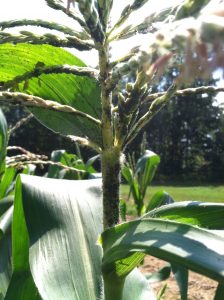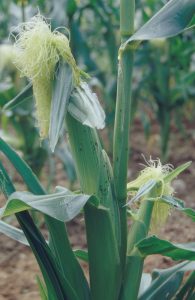Sweet Corn IPM Newsletter No. 7 — August 11, 2023
CORN EARWORM PRESSURE HIGHER IN SOUTH
Moth Counts Highly Variable by Location
SITUATION

Corn harvest is in full swing, although supply has been spotty from site to site. Continued heavy rains have plagued growers’ ability to spray and harvest the fields. Moth captures in pheromone traps were highly variable from site to site this week, with some farms seeing no moths while others had the highest counts of the season. Western bean cutworm moth counts remain high at most locations and could threaten silking corn that is not presently under a schedule for corn earworm.
European corn borer: All fields scouted this week were under threshold for larval feeding in pre-tassel corn. Moth counts also remained low at all sites this week. This suggests that the first generation of European corn borer may be over, but we could see a partial second generation emerge in September.
Corn earworm: Moth counts were much higher in some locations this week. However, other locations continue to catch few, if any moths. Based on this week’s moth counts, a 4-day spray interval for silking corn was recommended for Biddeford, Cape Elizabeth, New Gloucester and one Wells site. A 5-day spray schedule was recommended for Auburn, Bowdoinham, Dayton, Garland and Oxford. A 6-day spray interval was recommended for Palmyra. There continue to be concerns that pheromone traps may not be accurately representing moth populations very well, due to the variable weather. As a result, a more cautious approach to protecting corn may be considered. Growers should consider applying at least one protective spray at pre-tassel and another when silks first appear, especially if larvae are present in the field, regardless of pheromone trap catches.
Fall armyworm: Similar to corn earworm, armyworm moth counts were higher in many locations this week, but variable overall. Sites in Biddeford, Bowdoinham, Cape Elizabeth, Farmington, Garland, Monmouth, New Gloucester and one Wells site were over the three-moth threshold for silking corn. Low levels of larval feeding damage were found in some pre-tassel corn, but not over threshold at any location.
Western Bean Cutworm: Moth numbers remained high this week, ranging from 17 to 110 at our trapping sites. There are no specific thresholds for western bean cutworm moths in silking corn, but they behave very similarly to fall armyworm and corn earworm, so it is advisable to keep silking corn protected at this time, even if traps are catching very few earworm and/or armyworm. The threshold for feeding injury on pre-tassel to tassel plants is 8%.
Corn leaf aphids have become more prevalent in fields this week. Colonies of these small, bluish-green insects cover the tassels, stalks and husks. The waste they excrete stimulates the development of sooty mold, a black fungus that coats the surface of the husks. Sprays applied for corn earworm usually control aphids.
- Aphids on Corn; photo by Kaytlin Woodman
- Aphids on Corn Ear; photo by David Handley
Squash vine borer: Moth counts were under the five moth threshold for pumpkins and squash this week.
Sincerely,
David T. Handley
Vegetable & Small Fruit Specialist
Highmoor Farm
P.O. Box 179
52 U.S. Route 202
Monmouth, ME 04259
207.933.2100
UMaine Extension Diagnostic Research Lab
Pest Management Unit
17 Godfrey Drive
Orono, ME 04473
1.800.287.0279
| Location | CEW Moths | ECB Moths | FAW Moths | %Feeding Damage | Recommendations / Comments |
|---|---|---|---|---|---|
| Auburn | 4 | 0 | 1 | — | 5-day interval recommended for silking corn |
| Biddeford | 18 | 0 | 8 | 2% | 4-day interval recommended for silking corn |
| Bowdoinham | 5 | 0 | 3 | 3% | 5-day interval recommended for silking corn |
| Cape Elizabeth | 40 | 0 | 7 | 0% | 4-day interval recommended for silking corn |
| Dayton | 5 | 1 | 1 | 6% | 5-day interval recommended for silking corn |
| Farmington | 0 | 2 | 3 | 0% | One spray on silking corn for FAW |
| Garland | 4 | 0 | 3 | — | 5-day interval recommended for silking corn |
| Lewiston | 0 | 0 | 0 | — | No spray recommended |
| Monmouth | 1 | 0 | 7 | — | One spray on silking corn for FAW |
| New Gloucester | 22 | 0 | 7 | 1% | 4-day interval recommended for silking corn |
| Oxford | 4 | 0 | 1 | 0% | 5-day interval recommended for silking corn |
| Palmyra | 2 | 0 | 0 | — | 6-day interval recommended for silking corn |
| Wayne | 1 | 0 | 0 | 0% | No spray recommended |
| Wells I | 1 | 0 | 0 | 2% | No spray recommended |
| Wells II | 9 | 4 | 8 | 1% | 4-day interval recommended for silking corn |
CEW: Corn earworm (Only fresh silking corn should be sprayed for this insect.)
ECB: European corn borer
FAW: Fall armyworm
| Moths caught per week | Moths caught per night | Spray Interval |
|---|---|---|
| 0.0 to 1.4 | 0.0 to 0.2 | No spray |
| 1.5 to 3.5 | 0.3 to 0.5 | Spray every 6 days |
| 3.6 to 7.0 | 0.6 to 1.0 | Spray every 5 days |
| 7.1 to 91 | 1.1 to 13.0 | Spray every 4 days |
| More than 91 | More than 13 | Spray every 3 days |
Thresholds apply only to corn with exposed fresh silk. Lengthen spray intervals by one day if maximum daily temperature is less than 80°F.
European Corn Borer Thresholds
Whorl stage: 30% or more of plants scouted show injury.
Pre-tassel-silk: 15% or more of plants scouted show injury.
Silk: 5 or more moths caught in pheromone traps in one week.
IPM Web Pages:
Explore Integrated Pest Management in Maine — UMaine
Integrated Pest Management Data Visualization Tool — Penn State
Integrated Pest Management — UMass Amherst
Where brand names or company names are used, it is for the reader’s information. No endorsement is implied nor is any discrimination intended against other products with similar ingredients. Always consult product labels for rates, application instructions and safety precautions. Users of these products assume all associated risks.
In complying with the letter and spirit of applicable laws and pursuing its own goals of diversity, the University of Maine System does not discriminate on the grounds of race, color, religion, sex, sexual orientation, transgender status, gender, gender identity or expression, ethnicity, national origin, citizenship status, familial status, ancestry, age, disability physical or mental, genetic information, or veterans or military status in employment, education, and all other programs and activities. The University provides reasonable accommodations to qualified individuals with disabilities upon request. The following person has been designated to handle inquiries regarding non-discrimination policies: Director of Equal Opportunity, 5713 Chadbourne Hall, Room 412, University of Maine, Orono, ME 04469-5713, 207.581.1226, TTY 711 (Maine Relay System).


